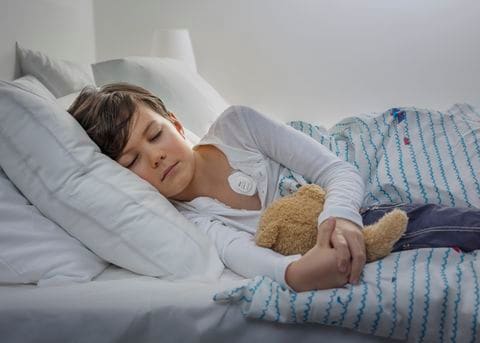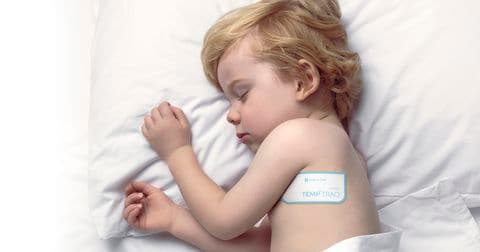Covid sparked interest in wearable thermometers, but you may be better off sticking to the basics
When Alison Borgmeyer’s three daughters returned to school in August, the Chicago-area nutritionist introduced wearable thermometers to her family’s health-care tool kit. To Borgmeyer, a self-proclaimed “data person,” information equals empowerment.
“If there’s a case in school where one of my girls may have been exposed, I use the thermometer for days at a time while we’re quarantining,” she says. The thermometers inform her decision-making about things such as when to visit the pediatrician and whether she should keep her daughters indoors.
Borgmeyer’s eldest daughter has sensory processing issues, which can make taking oral or tympanic (in-ear) temperatures challenging. With the wearable thermometer, Borgmeyer can just put it on her chest, and she isn’t bothered by the constant temperature checks.
Wearable — also known as continuous — thermometers have been on the market for several years. But with the continuing threat of the coronavirus and its more contagious new variants, their profile is reaching an all-time high. Here’s what you should know before buying one.
Pros and cons
Typically, wearable thermometers can be attached to a band worn around the wrist or arm, or incorporated into adhesives affixed to the chest or armpit. Their most appealing feature is their ability to remotely capture real-time changes in temperature over hours or days, sounding an alert when fever thresholds are crossed. Users can then upload this data to their phone or to the cloud to share with health-care providers. Some thermometers relay information to a free-standing base with an LCD display.
The biggest drawback of wearable thermometers is that, unlike the conventional thermometers most of us are accustomed to, they measure skin rather than core temperatures. These readings can differ by up to two degrees Fahrenheit. To correct for this difference, Ming Huang, a biomedical engineer at the Nara Institute of Science and Technology in Japan, and his colleagues designed prototypes that employ “algorithms to simulate the inner temperature from the skin temperature.” But most commercially available thermometers don’t yet incorporate this technology, and Huang notes that “individual differences make it difficult to fine-tune the parameters to apply to a larger population.”
User error and other factors are another challenge with wearable thermometers. Readings vary, for example, depending on where the sensor is located on the body, the temperature of the environment, and the wearer’s level of physical exertion.
Despite the drawbacks, researchers have begun using wearable thermometers to develop strategies to predict illnesses before the onset of symptoms. Benjamin Smarr, a professor at the University of California at San Diego, sees great potential in these tools and recently published research demonstrating that the early temperature changes they detect may be helpful in identifying pre-symptomatic coronavirus cases.
[Wearable tech can spot coronavirus symptoms before you even realize you’re sick]
When snapshots aren’t enough
For now, wearable thermometers are still a more familiar sight in hospital settings, where patients often need frequent temperature checks, but in the past few years, companies have upped their efforts to introduce reliable models to the consumer market.
Smarr compares conventional vs. continuous measurements to looking at planets going around the sun. “If you only get one snapshot,” he says, “all you can say is that that planet is in this solar system. You can’t really say whether it’s at the right point in its orbit for that time of year.” The data from wearable devices, instead, is like getting access to the frames of a movie. “As a result, we can do a much more sensitive job of figuring out when someone is wiggling out of their normal orbit.”
Theodoros Teknos, scientific director for the University Hospitals Seidman Cancer Center in Ohio, says the center uses wearable thermometers to “prevent sepsis in cancer patients by identifying temperature changes more rapidly and getting antibiotics started in a timely manner.” This sensitivity is especially important for “patients who are immunocompromised or who have low white blood cell counts because they often can’t mount the same levels of fever.” Conventional thermometers, used intermittently, may miss initial signs of fever in this population.
Alan Weller, a pediatrician at Robert Wood Johnson Medical School in New Jersey, doesn’t use wearable thermometers in his practice, either at the hospital or with his outpatient clients. However, he and his colleagues are investigating them for possible future use, including in postoperative patients, for example, where early intervention can mean the difference between a rampant infection and a good outcome.
 Masimo’s Radius T wearable thermometer can send notifications directly to your phone. (Masimo)
Masimo’s Radius T wearable thermometer can send notifications directly to your phone. (Masimo) Consumer use
Wearable thermometers’ information overload is probably not necessary for many consumers, and the more precise results of conventional thermometers make them the better choice for most people, Huang says. But wearables can be appropriate in some cases.
“There are situations,” Weller says, “in kids with special health-care needs, kids with language disorders or even, in some cases, younger children, where temperature monitoring that’s continuous may be helpful,” because these patients can’t otherwise communicate when they feel ill.
According to Jamie Hutton, a pediatrician practicing in Virginia and with the Maven Clinic, a telehealth company focusing on women’s and family health, continuous monitoring with a wearable thermometer might also be useful for febrile seizures in children. If these seizures occur at night, she says, parents often have no idea. In these scenarios, “it’s actually the fluctuation in temperature you’re looking for and how fast it goes up.”
The temperature fluctuations in female ovulation cycles are another natural candidate for continuous monitoring. The wearable thermometers used to “check fertility have actually been shown to be pretty accurate, because you don’t need the core temperature for that,” Hutton says. Tracking temperature fluctuations is sufficient to determine an individual’s ovulation window.
 TempTraq’s wearable temperature comes in the form of a patch. (TempTraq)
TempTraq’s wearable temperature comes in the form of a patch. (TempTraq) Features to look for
If you’re planning to buy a thermometer, first consider the user and under what conditions they would wear the device. And keep in mind that obtaining stable temperatures with wearable thermometers can be a challenge. “Some research shows that the under-the-arm Band-Aid types are the most accurate, since they are less influenced by the environmental temperature” and can be worn close to the skin for a more consistent reading, Hutton says.
Unlike wearable thermometers that measure the skin temperature of an extremity, the devices that sit in the armpit better reflect core temperature, especially if worn on the left side, which is closer to the heart. In contrast, the wrist and armband thermometers are more suited for people interested in tracking athletic performance, because “you’re going to be sweating, you’re going to be moving, and that thing’s not going to stay perfectly in place,” Hutton says.
Given the many choices available online, Teknos advises consumers to look for thermometers that have been tested “in a rigorous clinical setting with appropriate comparisons to core temperatures.” Relevant certifications include Food and Drug Administration device approval or adherence to ASTM-E1112 standards, a set of specifications for electronic thermometers determined by an international standards-developing organization.
Teknos also tells patients to select adhesive thermometers “that are easy to wear, unobtrusive and don’t cause significant discomfort.” Look for thin and flexible models, which are simple to camouflage under clothing. Another nice feature to seek out: thermometers that allow for the simultaneous monitoring of several people. In a hospital setting, “one caregiver can monitor 50 to 100 patients at once,” Teknos says. For parents, this means several children can be monitored at the same time, with the results uploaded to a central location.
Adhesive thermometers are sometimes sold as single-use, disposable devices resembling bandages or a small patch. Prices range from $25 for single-use thermometers to hundreds of dollars for top-of-the-line, reusable units. A basic reusable thermometer that can be used in conjunction with adhesive tape (refills are available separately) starts at about $50.
More information is not always better
Although continuous temperature monitoring may be useful in some cases, many doctors agree that for healthy adults and children, it veers toward overkill and could induce unnecessary anxiety. Hutton notes that body temperature naturally fluctuates over a 24-hour cycle. “If people don’t understand how it works,” Hutton says, “that could make them worry more.”
“It’s a double-edged sword, because we don’t want to create more stress by having [the thermometer] send a message to your phone every three minutes because it’s 100.5 or 100.8,” Weller says. Plus, when we’re inundated with data, we may lose the ability to filter out what’s important and what’s not.
Before you purchase wearable thermometers for yourself or your family, Weller suggests talking to your health-care provider. They may not be appropriate for your particular situation. But for the right patient and the right condition, they could be a lifesaver.
Editing by Kendra Nichols. Copy editing by Rachael Bolek. Photo editing by Monique Woo. Illustration by SanQian. Design by Alla Dreyvitser.






